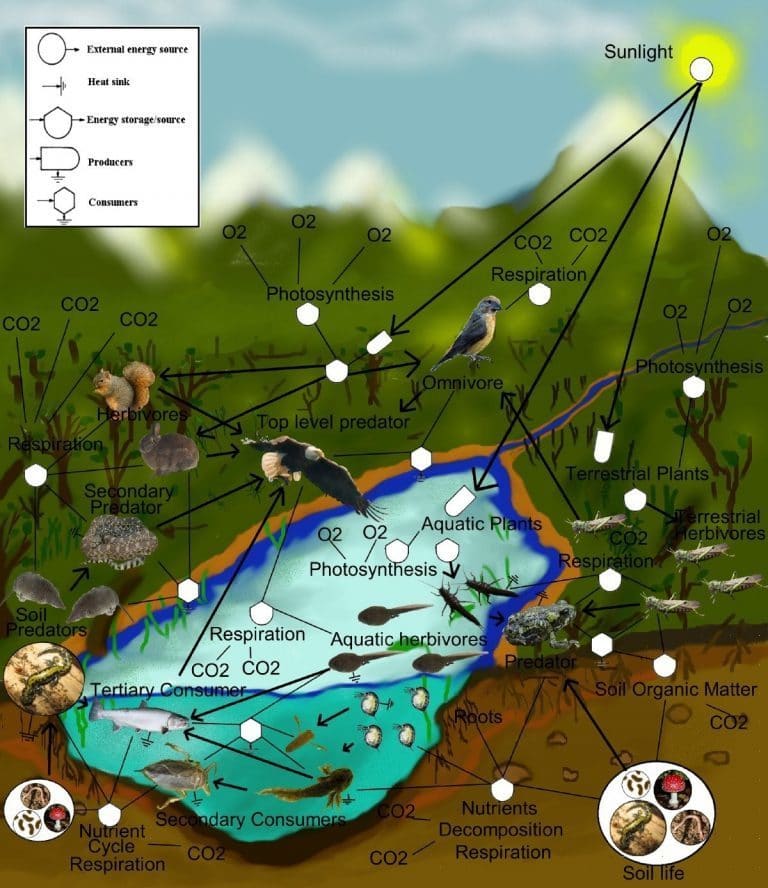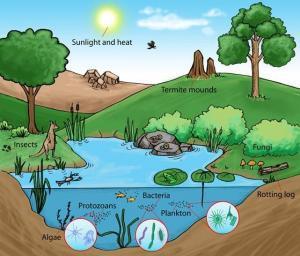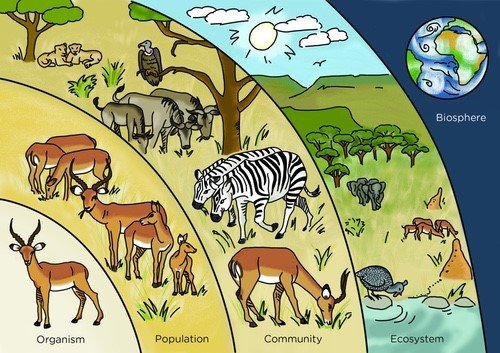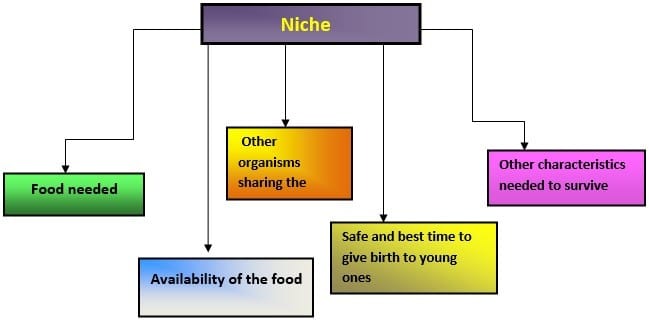Interactions of Living Things ( Worksheets,Definition, & Examples)
Grade 7 Science Worksheets
Step into a realm where the natural world comes alive with connections and relationships that shape the very fabric of life. Our 7th-grade science worksheets on the “Interactions of Living Things” are designed to take you on an exciting journey through ecosystems, adaptations, symbiosis, and more. Just like the intricate threads of a tapestry, living beings are intricately woven together, influencing one another in ways both seen and unseen.
How do organisms depend on each other in an ecosystem?
All living beings that coexist with each other like plants, animals, people, forming a habitat using the essential resource of nature like air, water, soil, and rocks makes up an ecosystem.
Living Elements and Non-Living Elements are called Biotic and Abiotic respectively.
Biotic include plants, animals, and human beings.
Abiotic include resources like air, water, soil and rocks.
Schedule a Free session to clear worksheet doubts
No credit card required, no obligation to purchase.
Just schedule a FREE Sessions to meet a tutor and get help on any topic you want!

Basic things needed for the survival all living things –
- Air
- Water
- Food
- Shelter
- Ability to respond and in the ecosystem

Organism
Any living thing like plant or animal is termed as an organism.
Population
A group of organisms of the same set of species, plant or animal is said to be population.

Credit: https://www.thinglink.com/scene/707599217928962049
Community
A community is a geographic area where many set of populations of plants and animals live and co-exist together.
Ecology
Ecology is the understanding of the relationships between living organisms and their surroundings.
Adapting to the Environment
- Natural selection is a tendency of a living being to adapt itself to an environment, eventually learning to live there and give birth to young ones.
- With necessary and favorable changes in behaviors and physical characteristics with respect to climate, availability of food and water, the organism learns to live in a particular place making that its Natural selection.
For example: a chameleon has learnt to adapt its environment by changing colors according to the surface it is standing.
- Niche is a particular role played by an organism in its habitat and how it makes its living.


What are the interactions between the levels of biological communities?
There are three types of interactions among organisms –
- Competition
- Predation
- Symbiosis
Competition
- It is the struggle between organisms as they attempt to use the same limited resource.
- Occurs when two species are in the same niche.
- Two species cannot share the same niche.
If two species occupy the same niche, they will be a competition to each other and one will species will become more powerful and destroy the other.
Predation
The relationship where one kills the other for food is called predation. The organism that kills is the predator. The organism that is killed is the prey.

Predation and Population Size
- If death rate is more than the birth rate, then population size decreases
- If birth rate more than the death rate, then population size increases
- When the death rate is more than the birth rate, the population of the prey decreases, . When this happens, the predators go without food and the predator population decreases.
- Predator and prey populations always fluctuate.
Here in this picture, every animal is a prey to the next animal and it also is a predator to the organism in front of it. It is also an example of food chain in animals
Adaptations of a predator
- Help them catch and kill prey.
- Cheetah’s speed helps it to run very fast in a very short time.
- Some scorpions and snakes when attack their prey have a venom that numbs the body of tiny animals like frogs and lizards.

Adaptations of a prey
- Prevent them from becoming prey.
- Speed and alertness of a mouse protects it from its predators like snake and eagles and owls.
- Smelly spray of a skunk.
Symbiosis
Organisms within a community do interact with each other in many ways. Some are predators, some are prey. Some have a tendency to compete with one another, some coexist. Some species form symbiotic relationships with other species.
Mutualism
Mutualism is when both parties are benefited in a particular relationship. There are a huge variety of such co existences.

For example, pollination, pollinators, such as bees and birds, sit on plants obtain nectar from them and in return carry pollen, which gets stuck on their bodies that the plants need for fertilization. Very much mutualistic, both the parties benefit.
- Cleaning symbiosis: In such relationships, one removes and cleans parasites and tiny worm organisms off another organism, which in turn provides a source of food. In return, the larger animal helps the cleaning animal to move around, here, the first organism provides not only food but transportation for the second organism. And the larger animal gets nicely cleaned up.
- Defense symbiosis: The clownfish and sea anemones in the large ocean share such a defensive relationship. The clown fish lives between the tentacles of sea anemones. They are of stingy nature, but it does no harm to the clownfish and its family. Because of this, clownfish lives in the safety of its tentacles while in return they protect the anemone from its predators. So here, both provide defense or protection.
Commensalism
Commensalism is an involvement between two different species where one species enjoys a benefit, and the other does not. For example, the cattle heron and little birds along with it go wherever the cattle and buffalo go and other herbivores as they graze. The birds eat the small insects and the worms when cattle graze around. In this relationship the birds benefits very much, but the cattle have no such benefit.

Parasitism
Parasitism is a relationship between two organisms where one is overly benefited, and the other is very much harmed. The parasite takes advantage of the other from the relationship, by harming the host.
Anything that is benefited while the other is harmed is considered a parasite. A mosquito is a parasite. While some of other parasites that affect humans are such as lice or bugs.
Parasites are divided by the type of interaction they have with their host. Parasites are much smaller than their hosts and reproduce very fast.
Ectoparasites are ones that breed and live on their hosts.
Examples: lice, mites. These parasites live on larger animals, like cats, dogs and deer.
Endoparasites are the ones that live inside their host.
Example: worms, bacteria and viruses. Worms which live inside our body, like tape worms and pin worms. Mostly they live inside the large intestine.

Learn more about Interactions of Living Things and other important topics with 7th Grade Science Tutoring at eTutorWorld. Our expert science tutors break down the topics through interactive one-to-one sessions. We also offer the advantage of customized lesson plans, flexible schedules and convenience of learning from home.
eTutorWorld Understands Math Tutoring | Online Math Worksheets are Important Tools
Understanding graphs, charts, and opinion polls in a newspaper, for calculating house and car payments, and for choosing a long-distance telephone service are impossible without strong math skills …and the only way to develop strong math skills is by constant practice.
‘Practice makes a man perfect’ holds true for no other field better than for math. A middle or high school student must set aside a minimum of an hour for math every day. Other than textbooks, worksheets help you revise and understand concepts better.
Our expert tutors prepare online maths worksheets that are age and grade-appropriate. Grade-wise math worksheets for Elementary Math, Arithmetic, Pre-Algebra, Algebra, Geometry, Trigonometry, Statistics, Pre-Calculus and Calculus can be solved to improve math skills, to get ahead or to even catch up.
You may download these FREE online math worksheets in the PDF format, and then print and email us their solutions for a free evaluation and analysis by eTutorworld’smath expert tutors.
You may solve these worksheets by yourself or with your peers while studying together.
The Answer Key at the end of each worksheet allows for a self-evaluation.
Personalized Online Tutoring
eTutorWorld offers affordable one-on-one live tutoring over the web for Grades K-12, Test Prep help for Standardized tests like SCAT, CogAT, MAP, SSAT, SAT, ACT, ISEE and AP. You may schedule online tutoring lessons at your personal scheduled times, all with a Money-Back Guarantee. The first one-on-one online tutoring lesson is always FREE, no purchase obligation, no credit card required.
For answers/solutions to any question or to learn concepts, take a FREE CLASS.
No credit card required, no obligation to purchase.
Just book a free class to meet a tutor and get help on any topic you want!
Check Point
Fill in the blanks:
- The study of the relationships between living organisms and their environment is called…………………….
- A group of organisms belonging to the same species, either plant or animal is called ………………….
- A geographic area where several populations of plants and animals live is called……………..
- …………………….. is the role of an organism in its habitat, or how it makes its living.
- ………………………. is the struggle between organisms as they attempt to use the same limited resource
Answer Key
- Ecology
- Population
- Community
- Niche
- Competition
What are interactions among living things?
Interactions among living things refer to the relationships and connections that organisms have with each other within ecosystems. These interactions can be cooperative, competitive, or symbiotic in nature.
What is the significance of studying interactions among living things?
Studying interactions among living things helps us understand how ecosystems function, how organisms adapt to their environments, and how the balance of nature is maintained. It provides insights into the complexities of life on Earth.
What are some examples of interactions among living things?
Examples include predator-prey relationships, where one organism hunts and consumes another for food; mutualism, where two species benefit from each other; parasitism, where one species benefits at the expense of another; and competition, where different species vie for the same resources.
How do interactions shape ecosystems?
Interactions shape ecosystems by influencing population sizes, distribution of species, and the flow of energy and nutrients. They determine which species thrive, which struggle, and how the overall ecosystem maintains its equilibrium.
What is a food chain?
A food chain is a linear representation of how energy and nutrients are transferred from one organism to another through their consumption. It typically starts with a plant or other producers and progresses through various levels of consumers.
Pricing for Online Tutoring
| Tutoring Package | Validity | Grade (1-12), College |
|---|---|---|
| 5 sessions | 1 Month | $139 |
| 1 session | 1 Month | $28 |
| 10 sessions | 3 months | $269 |
| 15 sessions | 3 months | $399 |
| 20 sessions | 4 months | $499 |
| 50 sessions | 6 months | $1189 |
| 100 sessions | 12 months | $2249 |
IN THE NEWS

Our mission is to provide high quality online tutoring services, using state of the art Internet technology, to school students worldwide.
Online test prep and practice
SCAT
SSAT
ISEE
PSAT
SAT
ACT
AP Exam
Science Tutoring
Physics Tutoring
Chemistry Tutoring
Biology Tutoring
Math Tutoring
Pre-Algebra Tutoring
Algebra Tutoring
Pre Calculus Tutoring
Calculus Tutoring
Geometry Tutoring
Trigonometry Tutoring
Statistics Tutoring
Quick links
Free Worksheets
Fact sheet
Sales Partner Opportunities
Parents
Passive Fundraising
Virtual Fundraising
Our Expert Tutors
Safe and Secure Tutoring
Interactive Online Tutoring
After School Tutoring
Elementary School Tutoring
Middle School Tutoring
High School Tutoring
Home Work Help
Math Tutors New York City
Press
©2022 eTutorWorld Terms of use Privacy Policy Site by Little Red Bird
©2022 eTutorWorld
Terms of use
Privacy Policy
Site by Little Red Bird






